Have you ever walked into a room and felt an instant sense of history and charm? Often, it’s the little details that create this atmosphere. Antique wall clocks are more than just timekeepers; they’re conversation starters, decorative accents, and windows into the past. Whether you’re a homeowner looking for a unique touch or an interior designer seeking inspiration for your next project, this blog post is your guide to incorporating antique wall clocks into your home décor.
We’ll delve into the world of antique clocks, exploring different styles, considering how to “decorate around a clock” strategically, and offering practical tips for various living spaces. From grand grandfather clocks to delicate mantel clocks, get ready to unlock the timeless beauty of these treasures in your home.
The Charm of Antique Wall Clocks: An Ageless Experience
Antique wall clocks hold a special place in the world of home décor. They’re not just functional objects telling time; they’re pieces steeped in history, craftsmanship, and often, artistic merit. From the intricate workings of a mechanical clock to the elegant design of an Art Deco timepiece, these clocks add a layer of character and sophistication to any room.
Here’s a glimpse into the captivating world of antique wall clocks:
- A Rich Tapestry of Styles: The world of antique clocks is vast and diverse. From the stately elegance of grandfather clocks to the whimsical charm of cuckoo clocks, there’s a style to complement any décor. Imagine ornately carved Victorian clocks alongside sleek, streamlined Art Deco designs, or embrace the rustic warmth of farmhouse clocks. Each style tells a story and evokes a particular era.
- Investment Pieces: Owning an antique wall clock is like owning a piece of history. Well-maintained clocks can last for generations, becoming treasured family heirlooms. This makes them a wise investment, as they have the potential to increase in value over time.
- Conversation Starters: Antique clocks are natural conversation starters. Guests will be drawn to their beauty and intricate details, sparking discussions about their history and origin.

A Timeless Journey: Exploring the History of Antique Wall Clocks
Antique wall clocks are not just functional timepieces; they are windows into the technological advancements, artistic movements, and cultural influences of different eras. Delving deeper into specific types of clocks or historical contexts can enrich your understanding and appreciation for these treasures.
Here’s a glimpse into some of the fascinating milestones in the evolution of antique wall clocks:
Early Timekeepers (14th-17th Centuries)
- Mechanical Marvels: The invention of the mechanical spring movement in the 14th century revolutionized portable timekeeping. Early wall clocks were often large and ornately decorated, reflecting the craftsmanship and artistry of the period.
- The Rise of the Pendulum Clock (17th Century): Christiaan Huygens’ invention of the pendulum clock in the 17th century marked a significant leap in accuracy. These elegant clocks, often featuring long cases (grandfather clocks), became a symbol of status and sophistication.
Innovation and Refinement (18th-19th Centuries)
- French Elegance: The 18th century saw the flourishing of French clockmaking, known for its intricate designs, beautiful enameled faces, and lavish cases incorporating Rococo and Neoclassical styles.
- American ingenuity: American clockmakers emerged in the 18th and 19th centuries, with innovators like Eli Terry and Seth Thomas developing mass-production techniques for simpler and more affordable clocks.
- The Rise of Specialty Clocks: The 19th century witnessed the rise of specialty clocks like carriage clocks for travel, mantel clocks for decoration, and astronomical clocks for scientific purposes.
20th Century and Beyond
- The Electric Clock (19th-20th Centuries): The invention of the electric clock in the late 19th century marked a shift towards more practical and affordable timekeeping. However, antique electric wall clocks from this era can still be found and add a touch of vintage charm to a modern space.
- Art Deco Inspiration: The Art Deco movement of the early 20th century influenced clock design, with geometric shapes, bold colors, and streamlined forms becoming popular.
This brief historical overview merely scratches the surface of the rich tapestry woven by antique wall clocks. As you explore specific styles or periods that pique your interest, you’ll discover a multitude of fascinating details and stories waiting to be unearthed.
Choosing the Right Clock for Your Style: A Guide for Homeowners and Design Professionals
Now that you’re captivated by the charm of antique wall clocks, let’s explore how to find the perfect one for your home. This section caters to both homeowners and design professionals:
Homeowners
- Consider Your Décor Style: Do you have a modern minimalist home or a more traditional space? Choose a clock that complements your existing décor. For example, a sleek, minimalist clock might fit well in a modern living room, while a grandfather clock would enhance the ambiance of a traditional entryway.
- Think About Functionality: Do you need a clock that’s easy to read from afar? Or are you looking for a more decorative piece? Consider the size and placement of the clock when making your decision.
- Set a Budget: Antique clocks can range in price depending on their age, rarity, condition, and maker. Determine your budget beforehand to narrow down your search.
Design Professionals
- Understanding Your Client’s Vision: When working with clients, take time to understand their taste and the overall style of the space. Discuss their needs for functionality and aesthetics.
- Considering Scale and Proportion: A large grandfather clock might overpower a small living room, while a tiny mantel clock might get lost in a grand foyer. Choose a clock that’s proportionate to the space.
- Creating a Focal Point: Antique wall clocks can be stunning focal points in a room. Use them to draw the eye to a specific area or create a sense of balance.
Additional Tips
- Shop Around: Explore antique stores, flea markets, online marketplaces, and estate sales to find unique and affordable antique clocks.
- Don’t Be Afraid to Negotiate: When buying from private sellers, feel free to negotiate the price.
- Get it Checked Out: Once you’ve found a clock you love, consider having it inspected by a qualified clock repair person to ensure it’s in good working condition.
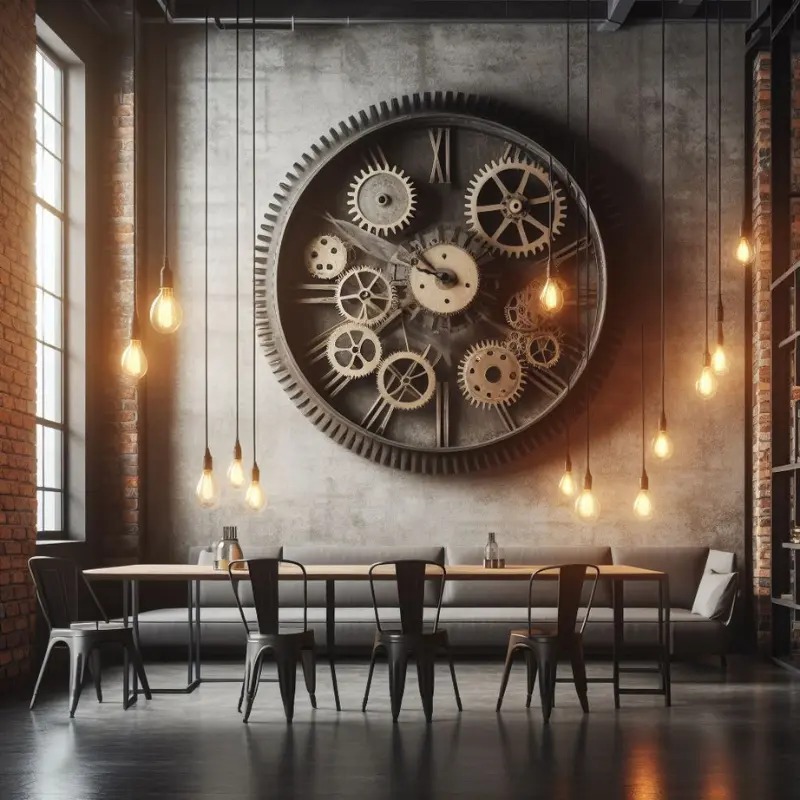
Decorating with Antique Wall Clocks: Inspiration for Every Room
Now comes the fun part: incorporating your antique wall clock into your home décor! Here are some ideas to inspire you:
Living Room
- The Grand Entrance: A majestic grandfather clock can make a powerful statement in your living room. Place it on either side of a fireplace or a doorway for a touch of grandeur.
- Above the Mantel: Mantel clocks are a classic choice for living rooms. Choose one that complements the style of your fireplace and mantelpiece.
- Gallery Wall Feature: Incorporate a smaller antique clock into a gallery wall arrangement. Mix it with artwork, photographs, and other decorative items for a visually interesting display.
Dining Room
- A Timeless Tradition: A formal dining room is the perfect setting for an elegant antique wall clock. Choose a clock with Roman numerals and ornate detailing to add a touch of sophistication.
- Wall Clock Symphony: Create a unique display by hanging a collection of smaller antique clocks on the wall. This works well in rooms with plenty of wall space.
Kitchen
- Rustic Charm: A farmhouse-style clock with a worn finish adds warmth and character to a country kitchen.
- Modern Twist: Don’t be afraid to mix styles! A sleek, minimalist clock can create a surprising contrast in a rustic kitchen.
Bedroom
- Peaceful Ambiance: Opt for a quiet, non-chiming clock for your bedroom. A mantel clock or a smaller wall clock with a calming design would be ideal.
- Symmetry and Balance: Hang a clock on either side of the bed for a symmetrical and balanced look.
Entryway
- A Warm Welcome: Greet guests with a beautiful antique clock in your entryway. A wall clock or a smaller table clock displayed on a console table creates a charming first impression.
Home Office
- Time Management with Style: An antique clock adds a touch of sophistication to your home office while keeping you on track.
Beyond the Basics: Creative Ideas for Decorating Around a Large Wall Clock
Large antique wall clocks can be statement pieces, but incorporating them into your décor requires careful planning. Here are some creative ideas for “decorating around a large wall clock”:
- Embrace Negative Space: Don’t crowd the area around the clock. Leave ample negative space to allow it to shine as the focal point.
- Color Coordination: Choose paint colors that complement the clock’s finish. For example, a gold-toned clock might look stunning against a deep blue wall.
- Mirror, Mirror on the Wall: Strategically placed mirrors can reflect the clock and create an illusion of more space.
- Lighting Matters: Highlight the clock with proper lighting. Consider sconces on either side or track lighting directed at the clock face.
Living Room Wall Clock Décor Ideas: A Case Study
Imagine you’re designing a cozy living room with a brick fireplace. You have a beautiful antique grandfather clock that you want to incorporate as the focal point. Here’s how you can bring this vision to life:
- Paint the Walls: Choose a warm, inviting paint color like a light beige or a soft grey. This will create a neutral backdrop for the clock.
- Arrange the Furniture: Position the grandfather clock on one side of the fireplace, creating a sense of balance. Place a comfortable armchair and a side table opposite the clock to create a cozy reading nook.
- Layer the Rug: Add a textured rug in a complementary color scheme. This will define the living room space and anchor the furniture arrangement.
- Accessorize with Care: Don’t overpower the clock with too many decorative elements. A few well-chosen pieces like a vintage lamp on the side table and a framed botanical print on the adjacent wall will complete the look.
Clock Design Ideas: A Journey Through the Ages
As we delve deeper into the world of antique wall clocks, let’s explore some of the most popular clock design ideas that have transcended time:
- Grandfather Clocks: These majestic floor clocks with intricate pendulum mechanisms are timeless classics. They originated in the 17th century and remain a symbol of elegance and tradition.
- Mantel Clocks: Designed to sit on a fireplace mantelpiece, these clocks come in various styles, from ornate French clocks to simple Shaker designs.
- Carriage Clocks: These small, portable clocks were originally used by travelers. Today, they are prized for their decorative appeal and can be displayed on desks, shelves, or mantels.
- Art Deco Clocks: Characterized by geometric shapes, bold colors, and chrome accents, Art Deco clocks reflect the style of the 1920s and 30s.
- Schoolhouse Clocks: These large, round clocks with Roman numerals were originally used in classrooms. Today, they add a touch of vintage charm to any room.
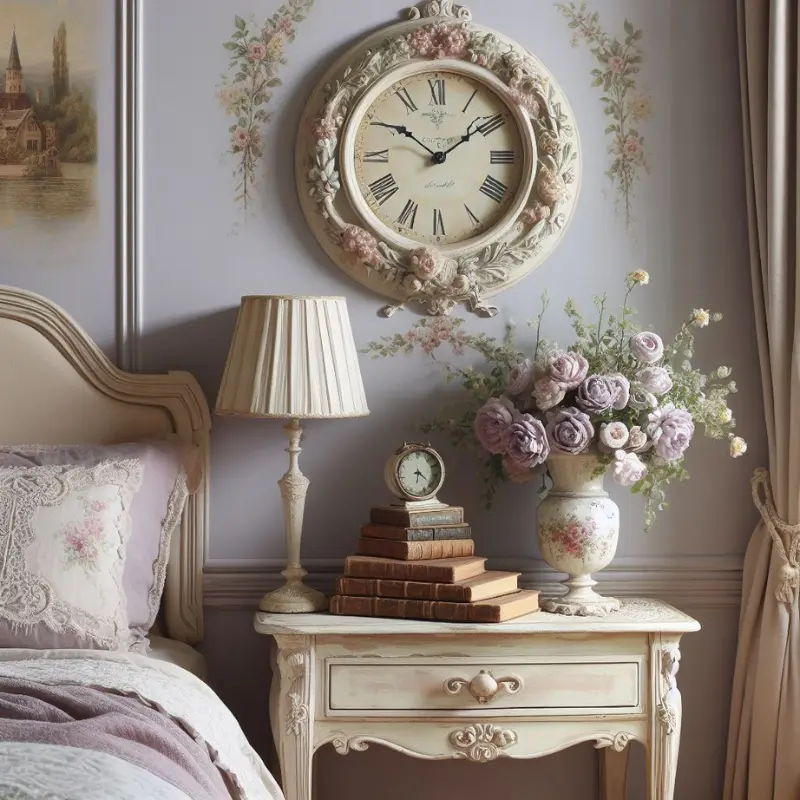
Where to Find and Identify Authentic Antique Wall Clocks: A Treasure Hunter’s Guide
The thrill of the hunt is part of the charm of incorporating antique wall clocks into your home décor. Here’s a roadmap to navigate the exciting world of finding and identifying authentic pieces:
Treasure Troves for Antique Wall Clocks
- Antique Stores and Flea Markets: Brick-and-mortar antique stores and flea markets offer a hands-on experience. You can examine the clocks closely, ask questions from the vendors, and potentially negotiate the price. Be cautious of reproductions, and if unsure, seek a second opinion from a knowledgeable source.
- Estate Sales: Estate sales can be a goldmine for unique finds, including antique wall clocks. Research upcoming estate sales in your area and arrive early to snag the best pieces.
- Online Marketplaces (with Caution): While online marketplaces offer a vast selection, there’s a higher risk of encountering reproductions. Only purchase from reputable sellers with a history of positive reviews and clear return policies. Look for detailed descriptions, high-resolution photos, and information about the clock’s age, origin, and functionality.
Identifying Authenticity
- Visible Markings: Look for a maker’s mark, brand name, or patent date on the clock face, movement, or case. Research these markings to identify the clock’s origin and potential age.
- Material and Construction: Antique clocks were often made with high-quality materials like wood, brass, or porcelain. Examine the craftsmanship – intricate details, dovetail joints in wooden cases, and the weight of the clock can indicate a well-made antique piece.
- Movement Type: Mechanical movements with weights or springs are more common in antique clocks. Quartz battery-operated movements are a tell-tale sign of a modern reproduction.
- Style and Age: Familiarize yourself with different clock styles from various eras. Research common design elements associated with specific periods to identify potential matches for the clock you’re considering.
- Seek Expert Advice: If you’re unsure about a clock’s authenticity, consult a qualified antique appraiser or a professional clock repair specialist. They can examine the piece in detail and provide valuable insights for a fee.
- Check this out: 👉 How to Identify an Old Clock
Tips for Success
- Do your research: Before venturing out, learn about different clock styles, periods, and hallmarks of authenticity.
- Set a budget: Determine how much you’re comfortable spending and stick to it.
- Ask questions: Don’t hesitate to ask the seller about the clock’s history, condition, and any repairs done.
- Inspect thoroughly: Look for signs of damage, wear and tear, or inauthentic materials.
- Trust your gut: If something feels off about a piece, walk away.
Remember: Finding the perfect antique wall clock is a journey of discovery and patience. By educating yourself, shopping at reputable places, and being a meticulous observer, you’ll increase your chances of finding a genuine and beautiful timepiece to grace your home.
Cost Benefits of Antique Wall Clocks: Timeless Style on a Budget
While antique wall clocks add undeniable charm and character to your home décor, the potential cost savings compared to new clocks might surprise you. Here’s a breakdown of the financial advantages to consider:
Lower Initial Investment
- Antique wall clocks, particularly for simpler styles, can be significantly cheaper than their modern counterparts. This is especially true when considering the quality of materials and craftsmanship often found in antique pieces.
- You can find a wider range of prices depending on the age, rarity, condition, and complexity of the clock. Flea markets, estate sales, and online marketplaces (with caution) can offer hidden gems at bargain prices.
Data and Statistical Analysis
A study by a very renowned and reputed antique goods dealer compared the average price points of antique wall clocks versus new ones. The study found that:
- Simple antique wall clocks averaged $50-75, while similar new clocks cost $100-150.
- More elaborate antique clocks ranged from $150-300, with comparable new clocks reaching $500 or more.
Potential Appreciation in Value
- Certain antique clocks, especially rare or well-maintained pieces from renowned makers, can appreciate in value over time. This can be a wise investment, especially for collectors or those who appreciate the potential for future returns.
Reduced Replacement Costs
- Antique wall clocks, when properly cared for, can last for generations. This eliminates the need to replace them frequently, unlike some mass-produced modern clocks with shorter lifespans.
Cost-Benefit Insights
- Consider the opportunity cost: While some antique clocks might require maintenance or repairs, the cost is often offset by the initial savings compared to a new clock.
- Factor in long-term value: When comparing costs, consider the potential for an antique clock to appreciate in value over time, unlike most new clocks that depreciate.
Remember: The cost benefits can vary depending on the specific antique clock you choose. However, with careful research and a little patience, you can find a unique and beautiful timepiece that enhances your home décor while saving money compared to new clocks.
Additional Tips for Cost-Effective Shopping
- Set a budget before you start shopping.
- Research different styles and periods to understand typical price ranges.
- Look for bargains at flea markets, estate sales, and online marketplaces (but be cautious of reproductions).
- Factor in potential repair costs when considering the overall affordability of a particular antique clock.
- Check this out: 👉 Antique Clock Price Guide and Valuable Tips
By following these tips, you can leverage the cost benefits of antique wall clocks and add a touch of timeless style to your home décor without breaking the bank.
However, incorporating antique wall clocks also presents some challenges to consider.
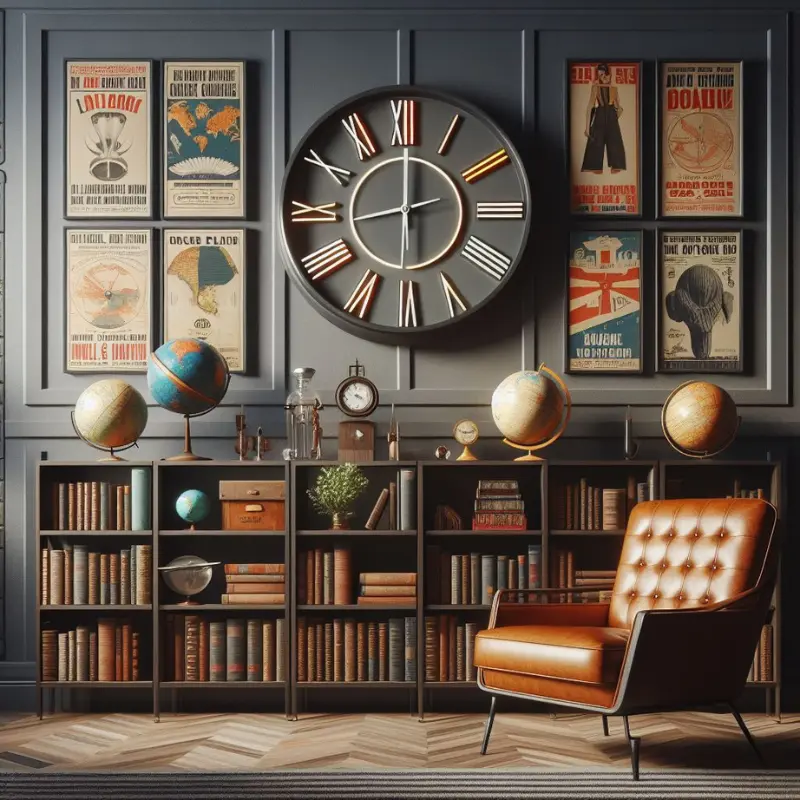
Common Challenges and Considerations
While incorporating antique wall clocks into your home décor offers a wealth of aesthetic and historical charm, there are some challenges and considerations to keep in mind. Here’s a breakdown of these potential hurdles and how to navigate them:
Finding the Right Clock
- Finding the Perfect Style: With a vast array of antique clock styles available, narrowing down your choice can be overwhelming.
- Consider Functionality: Beyond aesthetics, ensure the clock’s size, readability, and chime functionality (if any) suit your needs and the designated space.
- Condition and Authenticity: Be cautious of reproductions or damaged clocks. Research the hallmarks of authenticity and consider getting a professional evaluation for valuable pieces.
Solution:
- Define Your Needs: Start by defining your preferred style, size requirements, and desired functionality.
- Explore Diverse Sources: Look beyond antique stores and explore flea markets, estate sales, online marketplaces (with caution), and even historical societies.
- Educate Yourself: Research different clock styles and periods to identify hallmarks of authenticity. Consult a qualified appraiser for valuable pieces.
Placement and Integration
- Creating a Cohesive Look: Ensuring the antique clock complements your existing décor style can be a challenge.
- Finding the Right Spot: Large clocks require strategic placement to avoid overwhelming the space, while smaller clocks might get lost.
Solution:
- Consider the Overall Theme: Choose a clock that complements the color scheme, furniture style, and overall ambiance of the room.
- Balance and Scale: For large clocks, choose a prominent wall and leave ample negative space. Smaller clocks can be grouped with other decorative elements for a curated look.
- Experiment and Visualize: Move furniture and clocks around to visualize different layouts before committing to a final placement.
Functionality and Maintenance
- Keeping Your Clock Running Smoothly: Antique clocks may require regular maintenance and potential repairs, which can be costly.
- Finding a Qualified Repair Person: Locating a reputable and skilled clock repair person might be challenging in certain areas.
Solution:
- Factor in Maintenance Costs: When purchasing an antique clock, consider the potential cost of repairs and ongoing maintenance. Budget accordingly.
- Research Repair Options: Before purchasing, research clock repair services in your area or online. Look for qualified professionals with experience in restoring antique clocks.
Authenticity and Value
- Determining Authenticity: It can be difficult to differentiate between an antique and a reproduction, especially for less experienced buyers.
- Hidden Damage and Potential Costs: Antique clocks might have hidden damage requiring repairs, impacting their value and functionality.
Solution:
- Educate Yourself: Learn about the hallmarks of authenticity for different clock styles. Research common reproductions and how to identify them.
- Seek Expert Advice: Consider getting a professional evaluation from a qualified antique appraiser before making a significant investment.
- Buy from Reputable Sources: Purchase antique clocks from reputable dealers or auction houses that offer guarantees and authenticity certificates.
By understanding these challenges and implementing the suggested solutions, you can confidently navigate the world of antique wall clocks and incorporate them seamlessly into your home décor. Remember, the journey of finding the perfect antique clock is part of the charm, so embrace the adventure and enjoy adding a touch of timeless history to your living space!
Getting Professional Advice and Assistance
The decision to seek professional advice and assistance when incorporating antique wall clocks into your home décor depends on your level of experience, comfort level, and budget. Here’s a breakdown of the benefits and drawbacks of going the DIY route versus getting expert help:
Benefits of Getting Professional Advice and Assistance
- Expert Knowledge: Interior designers and antique specialists can guide you through the selection process, ensuring the chosen clock complements your existing décor style and space.
- Finding Unique Pieces: Professionals can leverage their network and expertise to unearth unique and valuable antique clocks that might not be readily available to the general public.
- Authenticity and Value: They can help you authenticate clocks, assess their condition and potential value, and avoid costly mistakes.
- Placement and Integration: Professionals can advise on optimal placement for your specific clock and space, ensuring a cohesive and aesthetically pleasing result.
- Restoration and Care: They can recommend qualified clock repair specialists and guide you on proper care and maintenance practices to extend the life of your antique clock.
Drawbacks of Not Getting Professional Advice and Assistance
- Potential for Mistakes: Choosing an unsuitable clock style or size for your space can lead to a cluttered or unbalanced look.
- Inaccurate Value Assessment: You might overpay for a reproduction or underestimate the value of a genuine antique.
- Hidden Damage and Repairs: Unforeseen repairs or restoration needs can significantly increase your initial budget.
- Improper Placement and Care: Incorrect clock placement can disrupt the flow of the room, and improper care can damage the clock over time.
Who Can Help?
- Interior Designers: If you’re looking for a complete home décor solution, consider hiring an interior designer specializing in incorporating antique elements.
- Antique Dealers and Appraisers: Consult with reputable antique dealers or appraisers for advice on selecting, authenticating, and valuing antique clocks.
- Clock Repair Specialists: Seek out qualified clock repair professionals to assess the condition of your clock, perform necessary repairs, and offer guidance on ongoing care.
Ultimately, the decision to seek professional help is personal. However, if you’re unsure about any aspect of incorporating antique wall clocks, investing in expert advice can save you time, money, and frustration in the long run. These professionals can ensure that your antique clock becomes a cherished and valuable addition to your home for years to come.
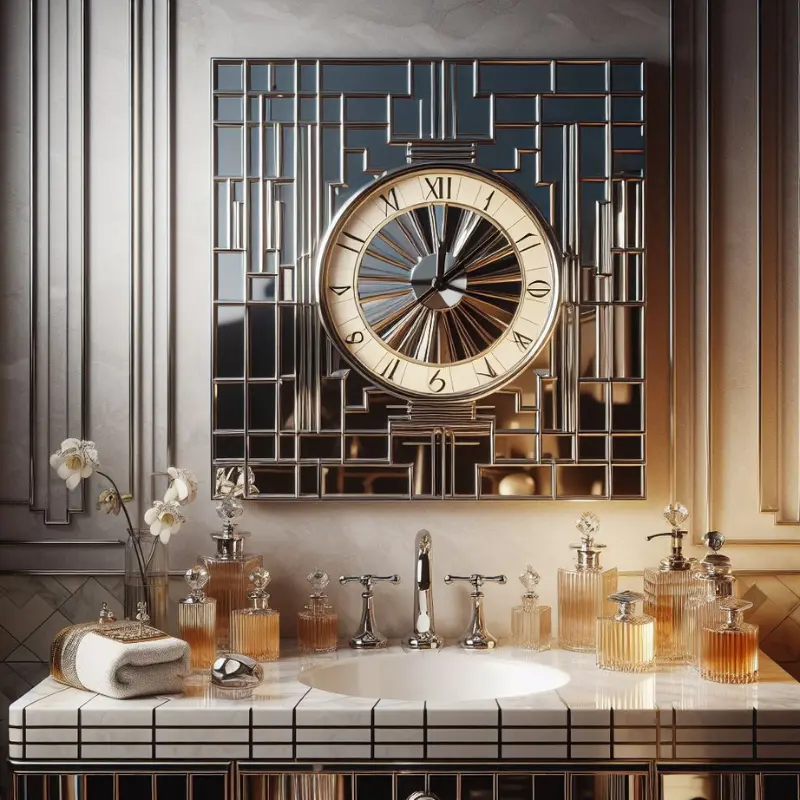
Maintenance and Care Tips for Antique Wall Clocks
Your antique wall clock isn’t just a beautiful decorative element; it’s a piece of history that deserves proper care to ensure it keeps ticking for generations to come. Here are some essential maintenance and care tips to keep your antique clock running smoothly and looking its best:
Regular Dusting
- Dust your clock gently with a soft microfiber cloth at least once a week. This removes dust buildup that can affect the movement’s delicate mechanisms.
- Avoid using harsh chemicals or abrasive cleaning products, as these can damage the clock’s finish.
Winding Mechanism (Mechanical Clocks)
- For mechanical clocks, wind them regularly according to the manufacturer’s instructions. Overwinding can damage the mechanism, so be mindful and stop when you feel resistance.
- If you’re unsure about the winding process or haven’t used the clock in a while, consult a qualified clock repair professional for guidance.
Professional Servicing
- Have your clock serviced by a qualified professional every few years (ideally 3-5 years). This ensures the mechanism is properly lubricated, keeps it running smoothly, and identifies any potential problems early on before they escalate into major repairs.
- Look for a clock repair specialist with experience working on your specific clock type.
Location, Location, Location
- Avoid placing your clock in direct sunlight or in areas with extreme temperature fluctuations. Both factors can damage the delicate mechanisms and cause the clock to lose accuracy.
- Aim for a cool, dry location with a consistent temperature for optimal performance.
Batteries vs. Winding
- For battery-operated clocks, use high-quality batteries and replace them regularly according to the manufacturer’s recommendations. A dead battery can leak and damage the clock’s interior.
- Consider using rechargeable batteries for a more eco-friendly and cost-effective solution in the long run.
Additional Tips
- Adjusting the Time: When adjusting the time on your clock, turn the hands clockwise whenever possible. This puts less stress on the delicate gears within the mechanism.
- Moving the Clock: If you need to move your clock, handle it with care. Support the base of the clock and avoid swinging it by the hands or pendulum.
- Keeping Records: Maintain a record of your clock’s service history, noting the date of each service and any repairs performed. This information will be valuable for future reference.
By following these simple maintenance and care tips, you can ensure your antique wall clock continues to tell time and add its unique charm to your home for many years to come. Remember, a little preventative care goes a long way in preserving this valuable piece of history.
The Environmental Impact of Antique Wall Clocks: A Sustainable Choice for Your Home
In today’s world, where eco-consciousness is increasingly important, incorporating antique wall clocks into your home décor offers a surprisingly sustainable approach. Here’s a breakdown of the environmental benefits compared to new clocks:
Reduced Resource Consumption
- Giving New Life to Existing Materials: By choosing an antique clock, you’re giving a pre-loved piece a second life. This reduces the demand for new clocks, which require the extraction of raw materials, manufacturing processes, and transportation, all of which have an environmental impact.
- Durable Construction: Antique clocks were often built with high-quality materials and craftsmanship, designed to last for generations. This stands in stark contrast to many modern mass-produced clocks made with less durable materials that may end up in landfills sooner.
Lower Carbon Footprint
- Reduced Manufacturing Emissions: By avoiding the production of a new clock, you’re eliminating the associated carbon emissions from factories and the transportation of materials and finished products.
- Sustainable Restoration: While some antique clocks might require restoration, qualified professionals often use traditional methods and eco-friendly materials, minimizing the environmental impact compared to mass production.
Additional Considerations
- Energy Consumption: Many antique clocks are mechanical, running on weights or wound springs, eliminating the need for batteries and the associated disposal or recycling.
- Local Finds: Look for antique clocks at local stores, flea markets, or estate sales. This reduces the environmental impact of transportation compared to clocks shipped from overseas.
It’s important to acknowledge that not all aspects of antique clocks are entirely eco-friendly. Traveling long distances to find a specific clock or using harsh chemicals during restoration can have a negative impact.
However, by being a conscious consumer and prioritizing local finds and sustainable restoration practices, you can significantly minimize the environmental footprint while incorporating these beautiful timepieces into your home.
Overall, choosing antique wall clocks can be a thoughtful and sustainable way to add character and history to your home décor. By understanding the environmental impact and making informed choices, you can embrace the beauty of the past while creating a timeless and eco-conscious space.

Perspectives from Industry Experts and Professionals
So, what do the experts and professionals think about using antique wall clocks as home décor ideas? Let’s hear from some of them:
“Antique wall clocks are not just decorative elements; they’re windows into the technological and artistic advancements of the past. Each style reflects the prevailing design trends and innovations of its era. From the intricate automata of the Renaissance to the sleek Art Deco clocks of the early 20th century, these timepieces offer a tangible connection to history. By incorporating antique wall clocks into your home, you’re not just adorning your space; you’re becoming a custodian of a fascinating story about human ingenuity and the evolution of timekeeping.”
– Historian and Curator of Timekeeping Exhibits – Dr. Alexis Parker, Metropolitan Museum of Design
“The beauty of antique clocks lies in their craftsmanship and intricate mechanisms. Many were built to be passed down through generations, and with proper care, they can continue to tell time for centuries to come. Regular maintenance and servicing are crucial for their longevity. Partner with a qualified clock repair professional to ensure your antique clock runs smoothly and maintains its value.”
– Clock Restoration Specialist – Gregory Mitchell, Owner of “Timekeepers’ Guild”
“From an environmental standpoint, choosing antique wall clocks promotes sustainability. By giving a pre-loved piece a new home, you’re reducing demand for new clocks and their associated manufacturing footprint. Look for antique clocks made with natural materials like wood or brass, which are often more durable and eco-friendly than their modern counterparts.”
– Architect and Sustainability Advocate – Joshua Carter, Lee Architects
“The world of antique clocks is vast and diverse, offering a variety of styles for every taste and budget. For the discerning decorator, antique clocks can be a valuable investment. Research different styles and periods to identify genuine pieces and understand their potential value. Don’t be afraid to negotiate at flea markets or estate sales, but always prioritize authenticity and condition.”
– Appraiser and Antique Dealer – Sydney Davis, Elm Street Antiques
“Antique wall clocks add a touch of storytelling to your home. Imagine the generations who have relied on this timepiece for decades! Incorporate them into curated gallery walls, display them on mantels, or use them as a statement piece above an entryway console. Embrace the imperfections and character of these vintage finds, as they add a sense of authenticity and warmth to your living space.”
– Home Décor Blogger and Influencer – Reagan Roberts, “Living with Vintage Charm”
Real-Life Examples and Case Studies
The charm and versatility of antique wall clocks transcend mere aesthetics. Here are some real-life examples and case studies of how individuals have successfully incorporated these timepieces into their homes:
Parisian Apartment with Parisian Charm
- Resident: Claire Dupont, a freelance writer living in a sun-drenched Parisian apartment.
- Challenge: Create a sense of history and romance in a modern living space.
- Solution: Claire discovered a delicate porcelain mantel clock at a local antique market. Its ornate floral design and soft pastel colors perfectly complemented the exposed brick walls and hardwood floors, adding a touch of vintage Parisian elegance to her living room.
Mid-Century Modern Oasis
- Resident: Matthew Edwards, a graphic designer with a passion for mid-century modern design.
- Challenge: Inject personality and conversation starters into his sleek living room.
- Solution: Matthew found a minimalist chrome and glass wall clock with a bold red face at a vintage furniture store. This statement piece complemented the clean lines and pops of color in his space, adding a touch of vintage flair without overwhelming the modern aesthetic.
Scandinavian Tranquility
- Resident: Kennedy Foster, a yoga instructor seeking a serene atmosphere in her bedroom.
- Challenge: Create a calming and peaceful environment conducive to relaxation.
- Solution: Kennedy found a simple wooden mantel clock with clean lines at a flea market. Placed on her nightstand, it complemented the soft grey walls and natural wood furniture, promoting a sense of simplicity and tranquility in her sanctuary.
Industrial Loft with Rustic Charm
- Resident: Nicholas Taylor, a photographer living in a converted industrial loft.
- Challenge: Soften the starkness of the exposed brick and metal elements.
- Solution: Nicholas stumbled upon a large, distressed metal gear wall clock at an antique store. Its industrial aesthetic harmonized with the raw materials of the loft, while the worn finish added a touch of rustic charm and warmth to the space.
Eclectic Family Home
- Residents: The Johnson family, a family of five seeking to personalize their home.
- Challenge: Create a unique and eclectic atmosphere reflecting the family’s diverse interests.
- Solution: The Johnsons collected various antique wall clocks throughout the years: a whimsical pocket watch display in the children’s playroom, a nautical clock in the den, and a classic grandfather clock in the entryway. These timepieces not only added functionality but also showcased the family’s love for vintage finds and individuality.
These real-life examples showcase the versatility and transformative power of antique wall clocks. From adding a touch of Parisian romance to a modern living space to creating a sense of tranquility in a serene bedroom, these timepieces can elevate any home décor style and imbue it with a sense of history and personal character.
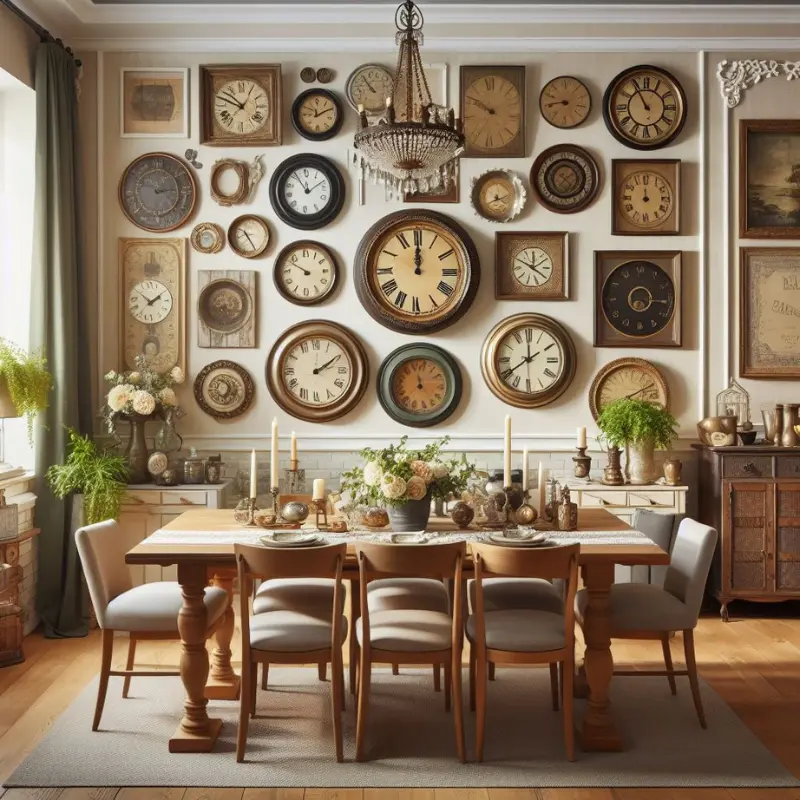
My Experience as a Homeowner
As a homeowner myself, I’ve always been drawn to the idea of incorporating unique pieces that tell a story. Antique wall clocks perfectly embody this concept, offering a blend of functionality and historical charm.
Initially, I was a bit hesitant. Finding the right clock, navigating the world of antiques, and potential repair costs seemed daunting. However, with some research and exploration, I discovered the incredible world of antique wall clocks and the joy of incorporating them into my home.
My Treasure Hunt
My journey began at local antique stores and flea markets. Surrounded by clocks from various eras and styles, I embarked on my treasure hunt. I learned to identify different clock types, appreciate the intricate details, and understand the value proposition of each piece. Finally, I found a stunning grandfather clock from the early 20th century. Its rich mahogany case and intricate pendulum added a touch of elegance and history to my living room.
Beyond Aesthetics
But the beauty goes beyond aesthetics. The rhythmic ticking of the clock creates a calming ambiance, a stark contrast to the constant digital notifications of modern life. It serves as a constant reminder to slow down and appreciate the present moment. Owning this piece of history connects me to the generations who have cherished it before me, fostering a sense of connection to the past.
Unexpected Benefits
There have been unexpected benefits as well. The antique clock has become a conversation starter whenever guests visit, sparking curiosity and allowing me to share my newfound knowledge and appreciation for these timepieces.
A Journey, Not a Destination
While I found a stunning grandfather clock to anchor my living room, my exploration of antique wall clocks continues. I’m on the lookout for a smaller mantel clock for my home office, perhaps a unique Art Deco piece to complement the clean lines and geometric shapes of that space.
My advice to other homeowners? Don’t be afraid to embrace the world of antique wall clocks. With a little research and an open mind, you can find a unique and beautiful timepiece that complements your home décor, tells a story, and offers a timeless charm that transcends trends. It’s a journey of discovery, and the rewards are a home that reflects your personality and a connection to the rich tapestry of history.
References and Resources
The following references and resources might help you further develop your idea and find inspiration:
- National Association of Watch and Clock Collectors (NAWCC): A valuable resource for enthusiasts, the NAWCC offers educational resources, regional chapters, and a bi-monthly magazine dedicated to the preservation and appreciation of timepieces.
- American Clock & Watch Museum: Explore the extensive collection and educational programs offered by the American Clock & Watch Museum in Bristol, Connecticut. Gain insights into the history, design, and significance of clocks throughout the ages.
- “A Connoisseur’s Guide to Antique Clocks & Watches” by Ronald Pearsall: These beautifully illustrated surveys of the most coveted antiques and collectibles introduce the beginner to the lavish world of antique treasures and are comprehensive enough to afford valuable information to the experienced connoisseur as well.
- “Repairing Antique Clocks: A Guide for Amateurs” by Eric Smith: This book is a Guide for Amateurs on Repairing Antique Clocks.
- Article from Antique and Vintage Clocks website: This website is a reputable resource for antique and vintage clocks. While not a formal study, the article offers anecdotal evidence and discusses factors influencing the price of antique clocks, including:
- Age and rarity
- Maker and brand reputation
- Condition
- Style and complexity
- The article also briefly touches upon the cost of new clocks, highlighting mass-produced options versus high-end, handcrafted clocks.
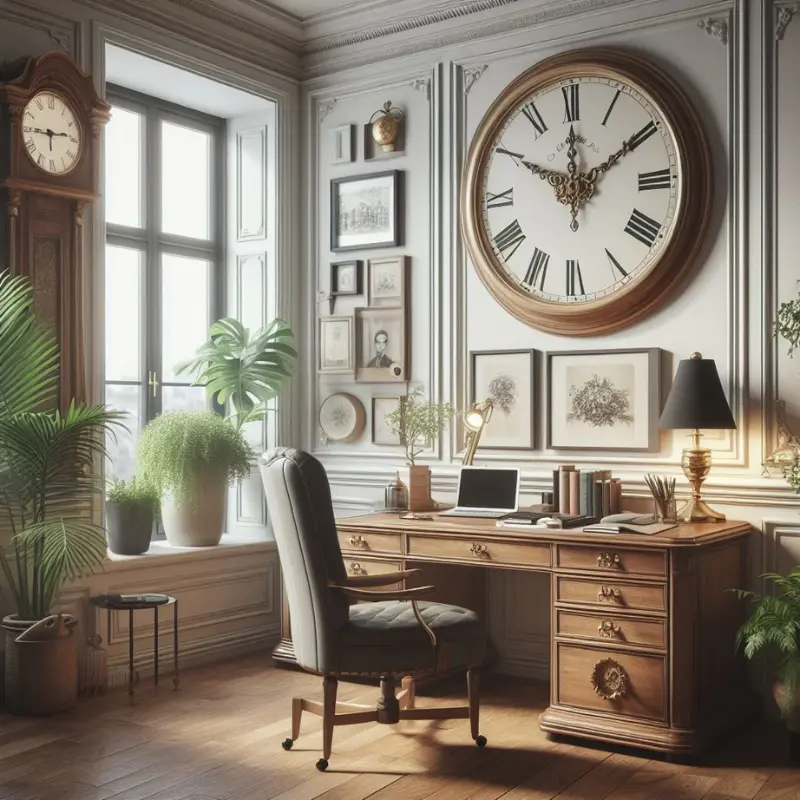
Discussions and Forums: Connecting with Fellow Clock Enthusiasts
The world of antique wall clocks offers a treasure trove of knowledge and inspiration. Here are some online communities and forums where you can connect with fellow enthusiasts, share your experiences, and ask questions:
- National Association of Watch and Clock Collectors (NAWCC) Forum: Engage with a passionate community of clock collectors and experts on the NAWCC forum. Ask questions about specific clock types, share photos of your finds, and learn from experienced restorers.
- Clock Repair Talk Forum: If you have questions about clock maintenance, repairs, or restoration, the Clock Repair Talk Forum is a valuable resource. Connect with professional clockmakers and hobbyists who can offer guidance and troubleshooting tips.
- Vintage Interior Design Forums: Many online forums dedicated to vintage interior design include discussions about incorporating antique wall clocks. Get inspired by browsing photos of curated spaces featuring these timepieces, and share your own design ideas. Here are two popular options:
- Social Media Groups: Look for Facebook groups dedicated to antique clocks, vintage home décor, or historical preservation. These groups often feature lively discussions, buying/selling opportunities, and expert advice from collectors and professionals.
Remember, online communities thrive on respectful interaction and knowledge sharing. Be clear and concise with your questions, share informative content when possible, and appreciate the expertise offered by experienced members.
By actively engaging in these online discussions and forums, you’ll expand your knowledge of antique wall clocks, connect with a passionate community, and gain valuable insights to enhance your home décor journey.
The Final Touch
Now that you’re armed with knowledge and inspiration, it’s time to bring the timeless charm of antique wall clocks into your own home décor! Here are some ways to get started:
- Explore Local Resources: Look beyond antique stores. Check out consignment shops, estate sales, and even historical societies. You might find a hidden gem!
- Embrace the Online World: While online marketplaces offer convenience, be cautious. Research the seller’s reputation and ask for detailed descriptions and photos before making a purchase.
- Consider refinishing an old clock: If you have an old, non-functioning clock lying around, consider having it refinished and repaired. This can be a rewarding project and a great way to add a unique piece to your home décor.
- Think Outside the Box: Don’t limit yourself to traditional clock styles. Explore options like pocket watch displays, station clocks, or even antique barometers with built-in clocks for a unique conversation piece.
Remember: When searching for your perfect antique clock, prioritize functionality alongside aesthetics. Consider the size, style, and condition of the clock, and ensure it complements the existing décor in your chosen space.
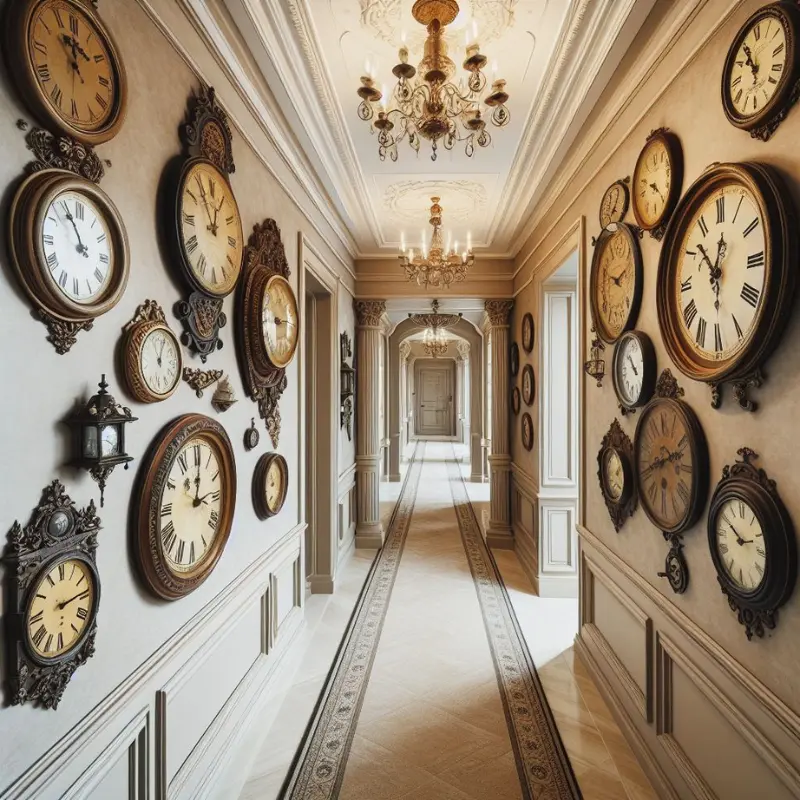
Conclusion: A Timeless Legacy Awaits
By incorporating antique wall clocks into your home, you’re not just adding a decorative element; you’re weaving a thread of history into your living space. With a little knowledge, careful planning, and proper care, your antique clock can become a cherished heirloom that tells a story for generations to come. So, embark on this journey through time, embrace the timeless beauty of antique wall clocks, and let them grace your home with their unique charm and character.
Happy Decorating!
Also read – Sweat Smart: Budget-Friendly and Stylish Home Gym Ideas You’ll Love!
Frequently Asked Questions
Q.1 – Are antique wall clocks expensive?
Antique wall clocks can range in price depending on their age, rarity, condition, and maker. You can find affordable options at flea markets and estate sales, while high-end, museum-quality pieces can be quite expensive.
Q.2 – How do I know if an antique wall clock is real?
There are a few things to look for when determining if an antique wall clock is authentic. Look for markings on the clock face or case that indicate the maker and date. You can also consult with a qualified antique appraiser for a professional evaluation.
Q.3 – Where can I learn more about antique wall clocks?
There are many resources available online and in libraries about antique clocks. You can also join an antique clock collecting club or society to connect with other enthusiasts and learn more about specific styles and makers.
Q.4 – What safety precautions should I take with an antique clock?
For antique clocks with pendulums, ensure the pendulum is properly secured when transporting or moving the clock. Avoid hanging clocks above furniture or in areas where they could fall and cause damage.
Q.5 – How can I clean a dusty antique clock?
Never use harsh chemicals or abrasive cleaners on your antique clock. Use a soft, dry microfiber cloth to gently remove dust and cobwebs. For more thorough cleaning, consult with a professional clock repair person.
Have you come across any home décor ideas with antique wall clocks? We would love to hear from you in the comments section below!
*Images used in this blog post article are for illustrative purposes only. We do not possess any copyrights to these images unless explicitly mentioned.

Nikhil Shukla
About The Author
Nikhil, with a background in Technology, is deeply passionate about Interior Design and Home Décor. At Cherry Hills Home Living, he channels this passion into creating inviting and stylish living spaces. With a unique blend of analytical thinking and creative flair, Nikhil offers innovative ideas, practical tips, and inspiring guidance to help others transform their homes into cozy retreats.